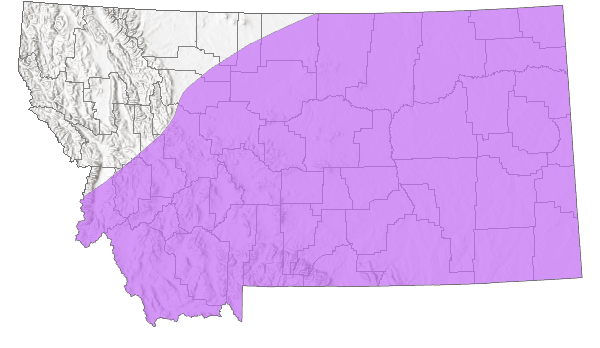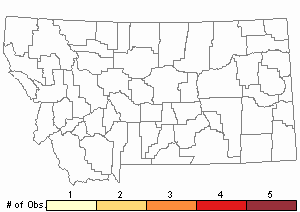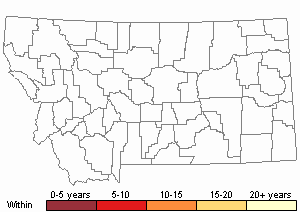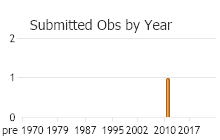View in other NatureServe Network Field Guides
NatureServe
Montana
Utah
Wyoming
Idaho
Wisconsin
British Columbia
South Carolina
Yukon
California
New York
Differential Grasshopper - Melanoplus differentialis
General Description
The following is taken from Vickery and Kevan (1985), Pfadt (2002), Capinera et al. (2004), Capinera and Sechrist (1982), and Scott (2010). This is a large yellow grasshopper with black markings. The outer face of the hind femur has contrasting chevron-like markings which readily distinguishes it from other Melanoplus species. Melanistic (black) forms (morphs) can be encountered in a population which are almost entirely black except for some pale-yellow markings on the top and bottom of the hind femur.
The Differential Grasshopper is a strong flier! Adults are capable of dispersal flights of over 100 miles, and heights have been observed at 1400 feet. Such flight seems to occur in the morning and when temperatures reach 81 degrees F (Pfadt 2002, and Schell et al. 2005).
Phenology
This species overwinters in the egg stage and begins to hatch in late spring. Adults occur from July to October. Specimens become progressively darker in color as the seasons progress (Vickery and Kevan 1985, and Capinera and Sechrist 1982).
Diagnostic Characteristics
The following is taken from Vickery and Kevan (1985), Pfadt (2002), Capinera and Sechrist (1982), Capinera et al. (2004), and Scott (2010). The body length to end of forewings is 28 to 37 mm for males, 34 to 50 mm for females. The shape of male’s genital cercus is distinctive, which are large and "boot-shaped" and the furcula are small and barely visible. The black chevron markings on the hind femur, of both males and females, are also diagnostic.
Due to its large size and striking color, the Differential Grasshopper can rarely be confused with any other Melanoplus species. There is a subspecies, M .d. nigricans, which is known only from eastern South Dakota, eastward through Minnesota, Wisconsin, Michigan and New Jersey (Vickery and Kevan 1985).
Species Range
Montana Range
Range Descriptions

 Native
Native
Range Comments
The Differential Grasshopper is widely distributed over much of the U.S., but absent in the northeastern, southeastern, and northwestern states. It is also absent in the Canadian provinces. It ranges from the mid-Atlantic Coast, west to the Pacific Coast in California, and north along the Canadian border, and south into Mexico. In Montana, this species has been reported for 17 counties, and probably widely distributed over the eastern half of the state. (Vickery and Kevan 1985, Pfadt 2002, Capinera et al. 2004, and Scott 2010).
Observations in Montana Natural Heritage Program Database
Number of Observations: 1
(Click on the following maps and charts to see full sized version)
Map Help and Descriptions
Relative Density

Recency


 (Observations spanning multiple months or years are excluded from time charts)
(Observations spanning multiple months or years are excluded from time charts)
Habitat
The following comes from Pfadt (2002), Schell et al. (2005). It was originally restricted to areas of tall herbaceous vegetation in wet meadows, swales, and creek bottomlands. With the habitat changes brought about by the advance of human settlement and agricultural development, it spread into weedy vegetation sites of crop borders and roadsides. Across much of its range, large populations can develop over extensive areas of croplands between the Rocky Mountain front and the Mississippi River.
Food Habits
This species is polyphagous, feeding on both grasses and forbs, but usually consumes more forbs than grasses. However, it grows faster, larger, and produces more eggs, when feeding on a mixture. Sunflowers, soybeans, corn, and wheat are readily consumed—but not alfalfa. It also prefers species in the Composite family,
Asteracae, such as ragweed, sunflowers, and
prickly lettuce (
Lactuca serriola) (Pfadt 2002, and Schell et al. 2005).
Reproductive Characteristics
The following comes from Pfadt (2002) and Schell et al. (2005). After hatching in early spring, the nymphs pass through 6 instars. The fledgling adults often fly into corn, and other crop fields, where they spend several weeks feeding to put on weight and size. During this time, they become sexually mature. Pairs form in the morning and copulation often continue for 20 to 24 hours. Females move to adjacent sod land or rank weeds to oviposit her eggs. She may brace herself against a grass or weed stalk and then work her ovipositor down in the soil. She deposits from 45 to 194 eggs amid the roots and forms a large pod around them. There is one generation per year.
Management
The following is taken from Pfadt (2002) and Schell et al. (2005). The Differential Grasshopper is prone to outbreaks and has a high potential reproductive potential. However, due to it being better adapted to warmer climates, its pest status is more severe in the southern latitudes of its range. This species range, habitat, etc. overlaps that of the
Two-striped Grasshopper, (
M. bivitattus), another serious pest. Thus, outbreaks of
M. differentials occur more frequently farther south while those of
M. bivitattus occur farther north. In Montana,
M. differentials is seldom likely to reach as severe outbreak levels as
M. bivitattus.
References
- Literature Cited AboveLegend:
 View Online Publication
View Online Publication Capinera, J.L. and T.S. Sechrist. 1982. Grasshoppers of Colorado: Identification, Biology, and Management. Fort Collins, CO: Colorado State University Experiment Station, Bulletin 584S. 161 p.
Capinera, J.L. and T.S. Sechrist. 1982. Grasshoppers of Colorado: Identification, Biology, and Management. Fort Collins, CO: Colorado State University Experiment Station, Bulletin 584S. 161 p. Capinera, J.L., R.D. Scott, and T.J. Walker. 2004. Field Guide to Grasshoppers, Katydids, and Crickets of the United States. Ithaca, NY. Cornell University Press.
Capinera, J.L., R.D. Scott, and T.J. Walker. 2004. Field Guide to Grasshoppers, Katydids, and Crickets of the United States. Ithaca, NY. Cornell University Press. Pfadt, R.E. 2002. Field Guide to Common Western Grasshoppers, 3rd edition. Laramie, WY: Wyoming Agricultural Experiment Station, Bulletin 912, modified by S. Schell and S. Schell for electronic publication. Accessed 19 February 2020. http://www.uwyo.edu/entomology/grasshoppers/field-guide/index.html#fieldguidetoc
Pfadt, R.E. 2002. Field Guide to Common Western Grasshoppers, 3rd edition. Laramie, WY: Wyoming Agricultural Experiment Station, Bulletin 912, modified by S. Schell and S. Schell for electronic publication. Accessed 19 February 2020. http://www.uwyo.edu/entomology/grasshoppers/field-guide/index.html#fieldguidetoc Schell, S.P., A.V. Latchininsky, and B.A. Shambaugh. 2005. Common Wyoming Pest Grasshoppers. 2nd Edition B-1161.Laramie, WY: University of Wyoming Cooperative Extension Service and Department of Renewable Resources. 76 p.
Schell, S.P., A.V. Latchininsky, and B.A. Shambaugh. 2005. Common Wyoming Pest Grasshoppers. 2nd Edition B-1161.Laramie, WY: University of Wyoming Cooperative Extension Service and Department of Renewable Resources. 76 p. Scott, R.D. 2010. Montana Grasshoppers, Katydids, and Crickets A Pictorial Field Guide to the Orthoptera. MagpieMTGraphics, Billings, MT.
Scott, R.D. 2010. Montana Grasshoppers, Katydids, and Crickets A Pictorial Field Guide to the Orthoptera. MagpieMTGraphics, Billings, MT. Vickery, V. R. and D. K. M. Kevan. 1985. The grasshopper, crickets, and related insects of Canada and adjacent regions. Biosystematics Research Institute, Ottawa, Ontario. Publication Number 1777. 918 pp.
Vickery, V. R. and D. K. M. Kevan. 1985. The grasshopper, crickets, and related insects of Canada and adjacent regions. Biosystematics Research Institute, Ottawa, Ontario. Publication Number 1777. 918 pp.
- Additional ReferencesLegend:
 View Online Publication
View Online Publication
Do you know of a citation we're missing? Anderson, N.L. 1951. Field studies on the biology of range grasshoppers of southeastern Montana. M.Sc. Thesis. Bozeman, Montana: Montana State University. 96 p.
Anderson, N.L. 1951. Field studies on the biology of range grasshoppers of southeastern Montana. M.Sc. Thesis. Bozeman, Montana: Montana State University. 96 p. Anderson, N.L. 1962. Grasshopper-vegetation relationships on Montana grasslands. Ph.D Dissertation. Bozeman, Montana: Montana State University. 73 p.
Anderson, N.L. 1962. Grasshopper-vegetation relationships on Montana grasslands. Ph.D Dissertation. Bozeman, Montana: Montana State University. 73 p. Bland, R.G. 2003. The Orthoptera of Michigan—Biology, Keys, and Descriptions of Grasshoppers, Katydids, and Crickets. East Lansing, MI: Michigan State University Extension, Bulletin E-2815. 221 p.
Bland, R.G. 2003. The Orthoptera of Michigan—Biology, Keys, and Descriptions of Grasshoppers, Katydids, and Crickets. East Lansing, MI: Michigan State University Extension, Bulletin E-2815. 221 p. Henry, J.E. 1969. Protozoan and viral pathogens of grasshoppers. Ph.D. Dissertation. Bozeman, MT: Montana State University. 153 p.
Henry, J.E. 1969. Protozoan and viral pathogens of grasshoppers. Ph.D. Dissertation. Bozeman, MT: Montana State University. 153 p. Kirk, K. and C.R. Bomar. 2005. Guide to the grasshoppers of Wisconsin. Madison, WI: Wisconsin Department of Natural Resources, Bureau of Integrated Science Services PUB-SS-1008. 154 p.
Kirk, K. and C.R. Bomar. 2005. Guide to the grasshoppers of Wisconsin. Madison, WI: Wisconsin Department of Natural Resources, Bureau of Integrated Science Services PUB-SS-1008. 154 p. Van Horn, S.N. 1963. The embryogenesis and embryonic variability of Aulocara elliotto Thomas (Acrididae Orthoptera). Ph.D. Dissertation. Bozeman, MT: Montana State University. 172 p.
Van Horn, S.N. 1963. The embryogenesis and embryonic variability of Aulocara elliotto Thomas (Acrididae Orthoptera). Ph.D. Dissertation. Bozeman, MT: Montana State University. 172 p.
- Web Search Engines for Articles on "Differential Grasshopper"
- Additional Sources of Information Related to "Insects"





